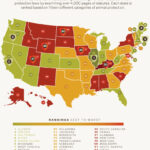In examining the phenomenon of animal cruelty, one might ponder: how does such a troubling behavior emerge? What drives individuals to inflict harm upon those who cannot speak for themselves? Understanding the roots of animal abuse is essential not only for addressing the issue itself but also for unveiling the larger societal constructs at play. Delving into this complex topic involves assessing various contributing factors, from psychological predispositions to social environments.
Animal cruelty often does not arise spontaneously; instead, it is the manifestation of multifaceted influences. One primary factor is the presence of systemic desensitization. As society progresses, individuals may become numb to the violence depicted in media or prevalent in certain communities. This desensitization can erode empathy, which is crucial for moral engagement. Research suggests that repeated exposure to violence—whether desensitization stems from horror films or real-world brutality—can distort perceptions of reality, making harm seem more permissible.
Moreover, the domicile environment plays a significant role in shaping an individual’s attitudes towards animals. Children raised in households where violence is commonplace or where animals are treated with contempt may internalize these behaviors as normal. Empirical studies indicate a correlation between childhood trauma and later aggressive behavior—both toward animals and people. The cyclical nature of violence is alarming, as unchecked aggression often begets more aggression. In this context, the family setting becomes a critical factor in understanding the predisposition to animal cruelty.
Additionally, factors such as socio-economic status cannot be overlooked. In challenging living conditions, individuals might become preoccupied with survival, leading to an environment where the humane treatment of animals is deprioritized. For some, the struggles of poverty create a landscape where animals are perceived as expendable resources or obstacles. This situation raises an ethical dilemma and poses the question: how can communities foster compassion towards animals in the face of economic hardship?
At a more systemic level, cultural attitudes towards animal welfare significantly influence behaviors. In societies where animals are viewed primarily as property or commodities, instances of cruelty may be more prevalent. The normalization of animal exploitation in various industries—such as agriculture, entertainment, and fashion—contributes to an overarching acceptance of abuse. One could argue that as long as society condones such treatment through consumer habits, the cycle of cruelty will continue unabated.
A further dimension to consider is the psychological aspect of potential abusers. Numerous studies have suggested a link between certain mental health conditions and the propensity to engage in animal cruelty. Issues such as conduct disorder, antisocial behavior, and even certain personality disorders may predispose individuals to act violently towards animals. However, it is paramount to approach this notion with care. Not every individual with a mental health condition will engage in such behaviors, and conflating psychological distress with violent tendencies can perpetuate harmful stereotypes.
Furthermore, the intersectionality of gender and animal cruelty merits attention. Statistical analyses indicate that males, particularly younger males, are disproportionately represented among animal abusers. While this is not to imply that females are exempt, the socialization of masculinity often encourages displays of dominance, aggression, and emotional suppression. These expectations can manifest in harmful behaviors toward vulnerable beings, reinforcing the need for critical examination and intervention strategies aimed at reshaping cultural narratives.
Considering all these factors, a clear question arises: how can we effectively challenge the roots of animal cruelty? Educational initiatives that focus on empathy and moral reasoning from a young age are paramount. Schools and communities can implement programs promoting kindness towards animals, aiming to instill a sense of responsibility and guardianship. This vital investment in our youth serves not only to reduce immediate instances of animal cruelty but also to foster a compassionate society in the long run.
Moreover, creating accessible channels for reporting and addressing abuse can fortify community accountability. The role of local governments and organizations is indispensable in implementing legislation that protects animals. By reinforcing the legal frameworks against cruelty, society can create an environment in which harmful behavior is met with appropriate consequences, thus elevating the standard of animal welfare.
Psychological support for potential abusers is another critical intervention. Addressing underlying mental health issues can be key to rehabilitation, fostering a transformation that diverts individuals away from violent tendencies. Additionally, social support systems must be strengthened, particularly in at-risk communities where animal neglect and abuse may be prevalent. A holistic approach, integrating mental health resources and community engagement, can effectively counteract the normalization of violence.
Ultimately, combating animal cruelty requires a concerted effort that transcends individual responsibility. It demands a collective reexamination of our values, societal structures, and cultural narratives. By deeply understanding the roots of abuse, society can initiate meaningful dialogues and strategies that pave the way for a future where all living beings are treated with the dignity and respect they inherently deserve. As we challenge ourselves with difficult questions regarding animal welfare, let us not shy away from seeking innovative solutions that ensure kindness prevails over cruelty.









